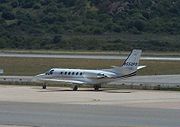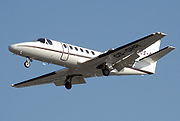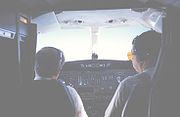
Cessna 550 Citation II
Encyclopedia
The Cessna Citation II was the first of the Model 550 series of Citation jets, which are light corporate jet built by Cessna
. A direct development of the Citation I
, the Citation II led to the later development of the Citation II/SP, the
S550 Citation S/II, and the Citation Bravo. The Citation II was also used by the United States Navy
under the designation T-47A for radar system training.
 The Citation II, Model 550, was a direct development from the Citation I. The earlier aircraft's success in the market led Cessna to believe there was demand for a larger aircraft that utilized the same design philosophy. The result was the Citation II, which had a maximum seating capacity
The Citation II, Model 550, was a direct development from the Citation I. The earlier aircraft's success in the market led Cessna to believe there was demand for a larger aircraft that utilized the same design philosophy. The result was the Citation II, which had a maximum seating capacity
of 10. In addition to more seats, the plane had more powerful JT15D-4 engines (2500 lbf (11.1 kN) thrust per engine), increase of fuel capacity of approximately 5000 lbs, faster speeds and longer range. First flight was on January 31, 1977, and the aircraft was certified for two-pilot operation in March, 1978. A total of 603 aircraft were built before the Citation II was replaced by the Bravo in the production line.
The US Customs & Border Protection purchased ten Citation IIs configured with the F-16's
APG-66(V)
fire control radar system and the WF-360TL imaging system. These aircraft have been used effectively in Panama, Honduras, Colombia, Peru, Venezuela, Mexico and Aruba and are not to be confused with the similar OT-47B aircraft, which are based on the Cessna Citation V
airframe.
_162761_usn_nellis_afb_nv_03.05.87r.jpg) The Model 552 T-47A was the designation given by the U.S. Navy to the Citation II. Fifteen aircraft were purchased by the Navy to train Naval Flight Officer
The Model 552 T-47A was the designation given by the U.S. Navy to the Citation II. Fifteen aircraft were purchased by the Navy to train Naval Flight Officer
s, primarily its Navy F-14 Tomcat
Radar Intercept Officers, Navy and Marine Corps A-6 Intruder
Bombardier/Navigators, Navy and Marine Corps EA-6B Prowler Electronic Warfare Officers, Marine Corps F/A-18D Hornet Weapon Systems Officers and Navy S-3 Viking
Copilot/Tactical Coordinators. The T-47A was modified by incorporating JT15D5 engines, shortened wings, multiple radar consoles and the AN/APQ-167 radar system.
The T-47As were operated by Training Air Wing Eighty Six, which was based at Naval Air Station Pensacola
, Florida. All but one of the T-47As were destroyed in a hangar fire, and the Navy replaced them with upgraded T-39s
 In October, 1983, Cessna announced that they would be improving the aircraft, and the upgraded Model S550 Citation S/II first flew February 14, 1984. The S/II could seat a maximum of 11 people. The aircraft utilized an improved version of the engine, JT15D-4B (2500 lbf (11.1 kN) of thrust). The "B" in the engine model number consists of components in the hot section being replaced with components sustaining higher IT temperatures which in turn allows for a higher N1 percentage of 106%, a full 2% more than the JT15D-4 engines installed on on the Citation II. The main benefit of the percent increase provided more thrust at higher altitudes. Fuel capacity was increased to a total of 5820 lbs. The rest of the improvements were aerodynamic in nature. The wing was replaced with one using a supercritical airfoil, which had been developed for the Citation III
In October, 1983, Cessna announced that they would be improving the aircraft, and the upgraded Model S550 Citation S/II first flew February 14, 1984. The S/II could seat a maximum of 11 people. The aircraft utilized an improved version of the engine, JT15D-4B (2500 lbf (11.1 kN) of thrust). The "B" in the engine model number consists of components in the hot section being replaced with components sustaining higher IT temperatures which in turn allows for a higher N1 percentage of 106%, a full 2% more than the JT15D-4 engines installed on on the Citation II. The main benefit of the percent increase provided more thrust at higher altitudes. Fuel capacity was increased to a total of 5820 lbs. The rest of the improvements were aerodynamic in nature. The wing was replaced with one using a supercritical airfoil, which had been developed for the Citation III
. The leading edges of the wing and tail used TKS type anti-icing fluid in addition to bleed air used for the engines. The S/II was certified, like the II/SP, with a single-pilot exemption. Once certification was in hand, the S/II replaced the II in the product line in late 1984. However, due to market demands, the II was returned to production in 1987. The S/II was discontinued after the 1988 production year. Number of S/II's Produced (approximate) 160. The II continued in production until 1994, and was replaced by the Bravo in 1997.
 By 1994, the Citation II and S/II had been in production for 10 years, and it was time to integrate new technology. Cessna thus announced the development of the Citation Bravo. While it was built on the basic S/II airframe, the new aircraft was powered by Pratt & Whitney Canada PW530A
By 1994, the Citation II and S/II had been in production for 10 years, and it was time to integrate new technology. Cessna thus announced the development of the Citation Bravo. While it was built on the basic S/II airframe, the new aircraft was powered by Pratt & Whitney Canada PW530A
engines. The main landing gear was replaced by the smoother-riding trailing link configuration adopted by other members of the Citation line, and the standard avionics suite was updated to the Honeywell Primus 1000 glass cockpit. The new aircraft first flew on April 25, 1995, but certification did not come for over a year, finally being granted in August 1996. Production of the Bravo ceased in late 2006 after 337 had been produced.

Cessna
The Cessna Aircraft Company is an airplane manufacturing corporation headquartered in Wichita, Kansas, USA. Their main products are general aviation aircraft. Although they are the most well known for their small, piston-powered aircraft, they also produce business jets. The company is a subsidiary...
. A direct development of the Citation I
Cessna Citation I
|-See also:-References:* Michell, Simon. Jane's Civil and Military Upgrades 1994-95. Coulsdon, Surrey UK:Jane's Information Group, 1994. ISBN 0-7106-1208-7....
, the Citation II led to the later development of the Citation II/SP, the
S550 Citation S/II, and the Citation Bravo. The Citation II was also used by the United States Navy
United States Navy
The United States Navy is the naval warfare service branch of the United States Armed Forces and one of the seven uniformed services of the United States. The U.S. Navy is the largest in the world; its battle fleet tonnage is greater than that of the next 13 largest navies combined. The U.S...
under the designation T-47A for radar system training.
Citation II

Seating capacity
Seating capacity refers to the number of people who can be seated in a specific space, both in terms of the physical space available, and in terms of limitations set by law. Seating capacity can be used in the description of anything ranging from an automobile that seats two to a stadium that seats...
of 10. In addition to more seats, the plane had more powerful JT15D-4 engines (2500 lbf (11.1 kN) thrust per engine), increase of fuel capacity of approximately 5000 lbs, faster speeds and longer range. First flight was on January 31, 1977, and the aircraft was certified for two-pilot operation in March, 1978. A total of 603 aircraft were built before the Citation II was replaced by the Bravo in the production line.
The US Customs & Border Protection purchased ten Citation IIs configured with the F-16's
F-16 Fighting Falcon
The General Dynamics F-16 Fighting Falcon is a multirole jet fighter aircraft originally developed by General Dynamics for the United States Air Force . Designed as an air superiority day fighter, it evolved into a successful all-weather multirole aircraft. Over 4,400 aircraft have been built since...
APG-66(V)
AN/APG-66
The AN/APG-66 radar is a solid state medium range Pulse-doppler radar designed by Westinghouse for use in the F-16 Fighting Falcon and in the U.S. Customs and Border Protection's C-550 Cessna Citation, US Navy P-3 Orion, and Piper PA-42 Cheyenne II's as well as the Small Aerostat Surveillance...
fire control radar system and the WF-360TL imaging system. These aircraft have been used effectively in Panama, Honduras, Colombia, Peru, Venezuela, Mexico and Aruba and are not to be confused with the similar OT-47B aircraft, which are based on the Cessna Citation V
Cessna Citation V
The Cessna Citation V is a turbofan-powered small-to-medium sized business jet built by the Cessna Aircraft Company in Wichita, Kansas. The Citation brand of business jets encompasses several distinct "families" of aircraft, and the Citation V was the basis for one of these families...
airframe.
Citation II/SP
Like the Citation I/SP, the Model 551 Citation II/SP was launched as Cessna's means of competing in the turboprop market, which predominantly are operated single-pilot, so the aircraft was re-certified for single-pilot operations.T-47
_162761_usn_nellis_afb_nv_03.05.87r.jpg)
Naval Flight Officer
A Naval Flight Officer is an aeronautically designated commissioned officer in the United States Navy or United States Marine Corps that specializes in airborne weapons and sensor systems. NFOs are not pilots per se, but they may perform many "co-pilot" functions, depending on the type of aircraft...
s, primarily its Navy F-14 Tomcat
F-14 Tomcat
The Grumman F-14 Tomcat is a supersonic, twin-engine, two-seat, variable-sweep wing fighter aircraft. The Tomcat was developed for the United States Navy's Naval Fighter Experimental program following the collapse of the F-111B project...
Radar Intercept Officers, Navy and Marine Corps A-6 Intruder
A-6 Intruder
The Grumman A-6 Intruder was an American, twin jet-engine, mid-wing attack aircraft built by Grumman Aerospace. In service with the U.S. Navy and U.S. Marine Corps between 1963 and 1997, the Intruder was designed as an all-weather medium attack aircraft to replace the piston-engined A-1 Skyraider...
Bombardier/Navigators, Navy and Marine Corps EA-6B Prowler Electronic Warfare Officers, Marine Corps F/A-18D Hornet Weapon Systems Officers and Navy S-3 Viking
S-3 Viking
The Lockheed S-3 Viking is a four-seat twin-engine jet aircraft that was used by the U.S. Navy to identify, track, and destroy enemy submarines. In the late 1990s, the S-3B's mission focus shifted to surface warfare and aerial refueling. The Viking also provided electronic warfare and surface...
Copilot/Tactical Coordinators. The T-47A was modified by incorporating JT15D5 engines, shortened wings, multiple radar consoles and the AN/APQ-167 radar system.
The T-47As were operated by Training Air Wing Eighty Six, which was based at Naval Air Station Pensacola
Naval Air Station Pensacola
Naval Air Station Pensacola or NAS Pensacola , "The Cradle of Naval Aviation", is a United States Navy base located next to Warrington, Florida, a community southwest of the Pensacola city limits...
, Florida. All but one of the T-47As were destroyed in a hangar fire, and the Navy replaced them with upgraded T-39s
Citation S/II

Cessna Citation III
|-See also:-External links:*...
. The leading edges of the wing and tail used TKS type anti-icing fluid in addition to bleed air used for the engines. The S/II was certified, like the II/SP, with a single-pilot exemption. Once certification was in hand, the S/II replaced the II in the product line in late 1984. However, due to market demands, the II was returned to production in 1987. The S/II was discontinued after the 1988 production year. Number of S/II's Produced (approximate) 160. The II continued in production until 1994, and was replaced by the Bravo in 1997.
Citation Bravo

Pratt & Whitney Canada PW500
-External links:*...
engines. The main landing gear was replaced by the smoother-riding trailing link configuration adopted by other members of the Citation line, and the standard avionics suite was updated to the Honeywell Primus 1000 glass cockpit. The new aircraft first flew on April 25, 1995, but certification did not come for over a year, finally being granted in August 1996. Production of the Bravo ceased in late 2006 after 337 had been produced.
Variants
- Citation II (Model 550) a larger stretched development of the Model 500 first produced in 1978. Initially replaced by the S/II in production, but was brought back and produced side-by-side with the S/II until the Bravo was introduced.
- T-47A (Model 552) is the military designation of the Citation II. The United States NavyUnited States NavyThe United States Navy is the naval warfare service branch of the United States Armed Forces and one of the seven uniformed services of the United States. The U.S. Navy is the largest in the world; its battle fleet tonnage is greater than that of the next 13 largest navies combined. The U.S...
purchased 15 T-47A aircraft as radar system trainers. - Citation II/SP (Model 551) single-pilot operations
- Citation S/II (Model S550) incorporated a number of improvements, especially an improved wing. Replaced the II in production.
- Citation Bravo (Model 550) updated II and S/II with new PW530A engines, landing gear and Primus 1000 avionics. The last Citation Bravo rolled off the production line in late 2006, ending a nearly 10 year production run of 337 aircraft.
Military operators
- Argentine ArmyArgentine ArmyThe Argentine Army is the land armed force branch of the Armed Forces of the Argentine Republic and the senior military service of the country.- History :...
- Spanish Air ForceSpanish Air Force-The early stages:Hot air balloons had been used with military purposes in Spain as far back as 1896. In 1905, with the help of Alfredo Kindelán, Leonardo Torres y Quevedo directed the construction of the first Spanish dirigible in the Army Military Aerostatics Service, created in 1896 and located...
- Myanmar Air Force
- Nigerian Air ForceNigerian Air ForceThe Nigerian Air Force is the air arm of the Nigerian Armed Forces.It is one of the largest in West Africa, consisting of about 15,000 personnel and aircraft including 15 Chengdu F-7s, and 24 Dassault-Dornier Alpha Jets, armed helicopters, and military transport aircraft. However in recent years...
- Swedish Air ForceSwedish Air ForceThe Swedish Air Force is the air force branch of the Swedish Armed Forces.-History:The Swedish Air Force was created on July 1, 1926 when the aircraft units of the Army and Navy were merged. Because of the escalating international tension during the 1930s the Air Force was reorganized and expanded...
- Turkish Air ForceTurkish Air ForceThe Turkish Air Force is the aerial warfare service branch of the Turkish Armed Forces. It ranks 3rd in NATO in terms of fleet size behind the USAF and Royal Air Force with a current inventory of 798 aircraft .-Initial stages:...
- United States NavyUnited States NavyThe United States Navy is the naval warfare service branch of the United States Armed Forces and one of the seven uniformed services of the United States. The U.S. Navy is the largest in the world; its battle fleet tonnage is greater than that of the next 13 largest navies combined. The U.S...
- Venezuelan Air Force
- Royal Saudi Air ForceRoyal Saudi Air ForceThe Royal Saudi Air Force , is the aviation branch of the Saudi Arabian armed forces. The RSAF has developed from a largely defensive military force into one with an advanced offensive capability...
Specifications (Cessna S550 Citation SII)


